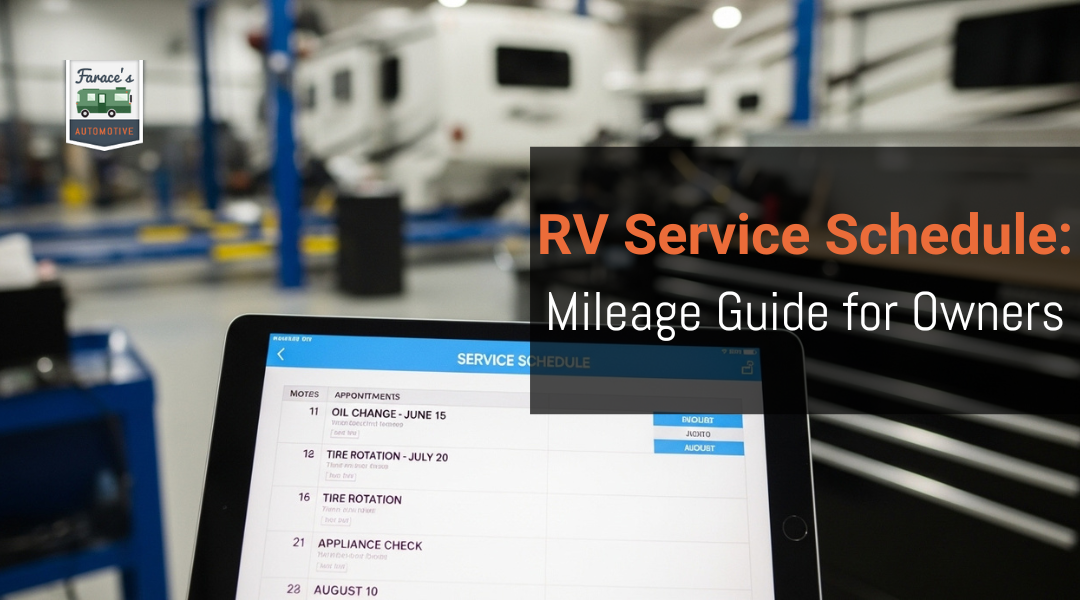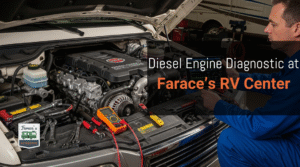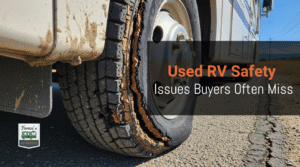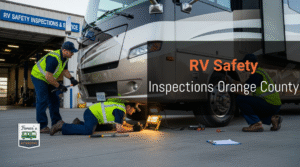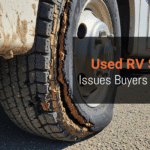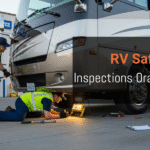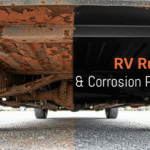Keeping your RV on the road isn’t just about fueling up and heading out—it’s about knowing when to service it based on how many miles you drive. Most RVs need an oil change and basic inspection every 3,000–5,000 miles to keep the engine and key systems running smoothly. Other components, like tires, brakes, and bearings, also follow mileage-based intervals that directly affect safety and performance.
When you track service by mileage instead of guessing, you prevent small issues from turning into expensive repairs. You also extend the life of your RV, which means more reliable trips whether you use it for weekend getaways or long cross-country drives.
This guide breaks down why mileage matters, the intervals you should follow, and which components demand the most attention. You’ll also see how local conditions in Southern California can change service needs and why working with a trusted shop like Farace’s Automotive & RV Center makes routine maintenance easier and more dependable.
Why Mileage Matters For RV Maintenance
Mileage directly affects how often you need to inspect and service your RV. Wear on the engine, tires, and braking systems increases with every mile, making mileage-based service intervals a reliable way to schedule maintenance. Time also plays a role, but the distance you travel often drives the most critical service needs.
How RV Usage Differs From Passenger Vehicles
Unlike passenger cars, RVs combine both a living space and a motorized vehicle. This means you must consider not just the drivetrain but also systems like plumbing, propane, and electrical components. However, mileage has a more direct impact on mechanical parts that keep you safely on the road.
For example, oil and filter changes are typically recommended every 3,000–5,000 miles for motorized RVs. Tire inspections and rotations should occur about every 5,000 miles, since RV tires carry heavier loads than car tires and wear differently. Brake checks are often suggested at 10,000 miles or annually, whichever comes first.
Towable RVs, such as travel trailers and fifth wheels, also have mileage-based needs. Bearings often require repacking every 10,000 miles, and hitch components should be inspected regularly to avoid towing issues. These intervals highlight how distance traveled directly determines when components need attention.
Mileage vs. Time-Based Maintenance – Which One Matters More?
Mileage-based service is critical when you spend a lot of time on the road. High mileage quickly wears down fluids, belts, and tires, so following manufacturer-recommended intervals helps prevent breakdowns. If you travel thousands of miles each season, mileage should be your primary guide.
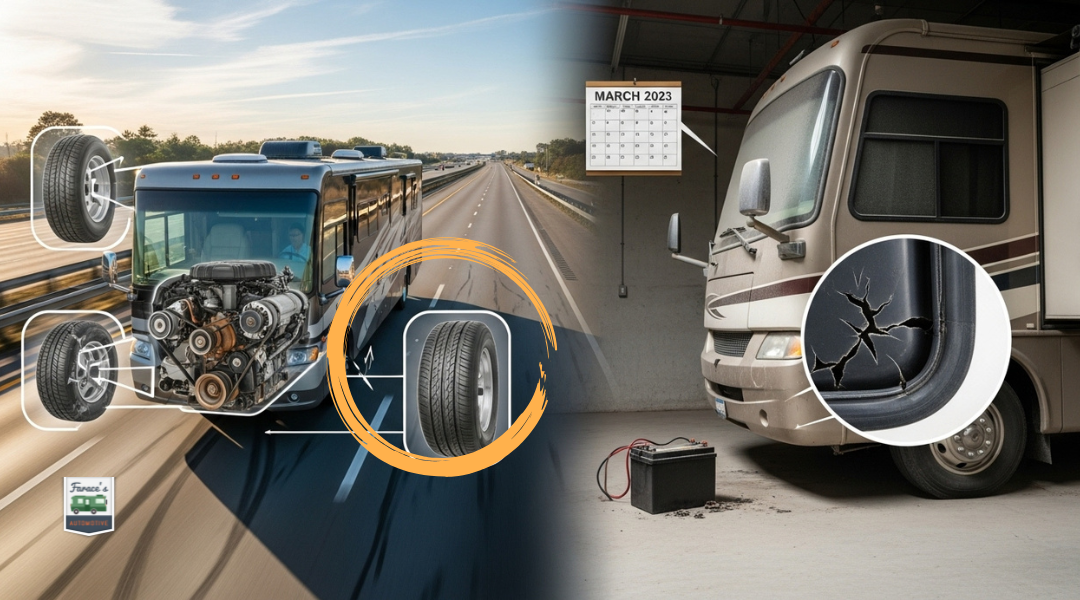
Time-based maintenance becomes more important if your RV spends long periods in storage. Batteries lose charge, seals dry out, and fuel can degrade even when mileage is low. In these cases, annual inspections and seasonal checks catch problems that mileage alone won’t reveal.
A balanced approach works best. Use mileage to schedule key mechanical services like oil changes, brake inspections, and tire rotations. At the same time, apply time-based checks for systems affected by age, such as roof seals, plumbing, and propane lines. This combination ensures both frequent travelers and occasional users cover all maintenance needs.
RV Service Intervals By Mileage
Your RV’s maintenance needs change as mileage adds up. Some tasks focus on protecting the engine and drivetrain, while others keep safety systems like brakes and tires in top condition. Following mileage-based service intervals helps prevent wear from turning into costly repairs.
Every 3,000–5,000 Miles: Engine Oil, Filters, And Basic Checks
At this range, the most important task is an oil change. Engine oil breaks down with use, and fresh oil keeps the engine lubricated and running efficiently. Replace the oil filter at the same time to prevent debris from circulating through the system.
You should also check air filters and fuel filters. A clogged air filter reduces performance and fuel efficiency, while a dirty fuel filter can strain the fuel pump. Replacing these items regularly helps maintain smooth operation.
Basic checks at this interval include tire pressure, fluid levels, and lights. Confirm coolant, brake fluid, and windshield washer fluid are topped up. Inspect belts and hoses for cracks or wear before they become a problem.
Every 10,000–15,000 Miles: Brakes, Tires, And Fluid Replacements
At this stage, you need to focus on brake system inspections. Check brake pads for thickness and replace them if they are worn. If your RV has drum brakes, inspect the shoes and hardware as well. Brake fluid should also be tested and replaced if it shows signs of moisture contamination.
Tires require close attention. Perform a tire rotation to ensure even wear across all wheels. Inspect tread depth and sidewalls, and verify that alignment is correct to prevent uneven wear patterns.
Other fluids may also need service. For example, power steering fluid and coolant can degrade over time. Replacing them as recommended by the manufacturer helps prevent overheating or steering issues.
Every 20,000–30,000 Miles: Transmission, Suspension, And Bearings
Your transmission fluid should be changed within this mileage range. Clean fluid ensures smooth shifting and reduces strain on transmission components. Delaying this service can shorten the life of the transmission.
Inspect the suspension system, including shocks, struts, and bushings. Worn suspension parts affect handling and ride quality, especially when carrying heavy loads. Replacing failing components improves stability and safety.
For towable RVs, pay attention to wheel bearings. Bearings should be cleaned, inspected, and repacked with grease about every 20,000 miles or annually. Neglecting this step risks overheating and potential wheel failure.
Beyond 50,000 Miles: Major Systems And Preventive Overhauls
Once your RV passes 50,000 miles, larger systems require attention. Timing belts or chains may need inspection or replacement depending on your engine type. Ignoring these parts can result in severe engine damage.
Have a technician evaluate the drivetrain and differential fluids. These fluids protect gears under heavy loads, and replacing them extends component life.
You should also schedule a thorough cooling system flush, replacing hoses and clamps as needed. At this stage, preventive overhauls such as upgrading brake lines, replacing suspension bushings, and checking electrical wiring help keep your RV reliable for long-term use.
Critical RV Components That Need Regular Service
Keeping your RV safe and reliable requires attention to both driving systems and living systems. From the engine and drivetrain to the roof, generator, and interior appliances, each part has its own maintenance schedule that directly affects performance, comfort, and safety.
Engine And Drivetrain Maintenance
Your RV’s engine and drivetrain need consistent servicing based on mileage. Oil and filter changes should occur every 3,000–5,000 miles for motorized RVs, or annually if driven less. This prevents buildup that can shorten engine life.
Check belts, hoses, and fluids such as coolant and transmission fluid. Replacing worn parts before failure reduces the risk of breakdowns. Inspect the air filter every 12,000–15,000 miles and replace it if clogged.
Tires are part of the drivetrain system you rely on. Monitor tire pressure before every trip and rotate them about every 5,000–7,000 miles. Proper inflation improves fuel efficiency and lowers the chance of blowouts.
Roof Inspections And Leak Prevention
The roof is one of the most vulnerable areas of your RV. Seals around vents, skylights, and edges can crack over time, leading to water intrusion. Inspect the roof at least every 3–6 months, especially after long trips or harsh weather.
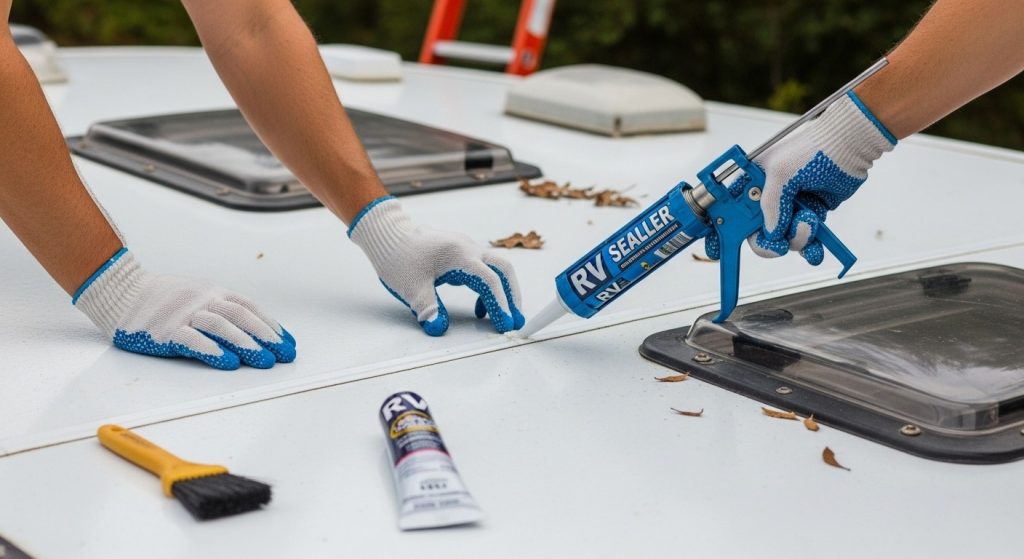
Use a ladder and walk carefully on reinforced areas. Look for soft spots, discoloration, or peeling sealant. Addressing small cracks early prevents expensive structural damage.
Apply sealant or roof coating as needed, following manufacturer guidelines. A yearly professional inspection is recommended if you store your RV outdoors or in humid climates.
RV Generator Servicing
Your generator needs maintenance based on both hours of use and storage time. Most manufacturers recommend an oil change every 100 hours of operation or at least once a year. Neglecting this can cause fuel gumming and hard starts.
Run the generator for about 30 minutes each month, even during storage. This keeps fuel moving through the system and prevents buildup. Check the air filter and spark plug during each service interval.
Keep track of service intervals in a log. A simple table helps:
| Task | Interval |
|---|---|
| Oil change | Every 100 hours or annually |
| Air filter check | Every 100–150 hours |
| Exercise run | 30 minutes monthly |
Interior Appliances And Electrical Systems
Interior systems require as much attention as mechanical parts. For the air conditioner, clean or replace filters once or twice per season. Dirty filters reduce cooling efficiency and strain the unit.
Inspect the water heater annually by draining and flushing it. Sanitizing the freshwater system every six months prevents bacteria growth. Check the propane system for leaks at least once a year.
Electrical systems also need regular checks. Test outlets, fuses, and circuit breakers before extended trips. Batteries should be inspected monthly for charge level and corrosion. Adding distilled water when needed extends battery life and ensures reliable power.
Special Considerations For Southern California RV Owners
Owning an RV in Southern California requires attention to environmental factors that affect both the mechanical systems and the living space. Heat, salt air, and extended sun exposure can accelerate wear, while storage habits and year-round use patterns determine how often service is needed.
Heat, Salt Air, And Sun Exposure In Huntington Beach
Coastal areas like Huntington Beach expose your RV to salt-laden air, which speeds up corrosion on metal components. Frames, suspension parts, and undercarriage hardware are especially vulnerable. Regular undercarriage rinsing and applying protective coatings help reduce rust.
Constant sunlight also takes a toll. UV rays fade paint, weaken seals, and dry out roof materials. Using a UV-resistant cover or parking under shade reduces long-term damage. Check roof seams and window seals more often than the standard annual schedule.
Heat adds another layer of stress. High temperatures accelerate fluid breakdown in the engine, transmission, and generator. You may need to replace oil, coolant, and transmission fluid sooner than mileage intervals suggest. Monitoring tire pressure is also critical, since heat increases blowout risk.
A simple checklist for coastal RV care:
- Wash and rinse undercarriage monthly
- Inspect seals and caulking every 3-4 months
- Apply UV protectant to roof and exterior surfaces
- Check and top off fluids more frequently in summer
Seasonal Storage vs. Year-Round RV Use
If you store your RV for part of the year, Southern California’s mild climate can still create issues. Long-term storage without preparation leads to flat spots on tires, drained batteries, and dried-out seals. Using tire covers, disconnecting batteries, and running the generator monthly helps prevent these problems.
Year-round use has different demands. Frequent driving keeps fluids circulating and seals lubricated, but it also increases service intervals. Oil changes, brake checks, and tire rotations often come up sooner when you log consistent mileage.
Moisture buildup is another concern. Even in a dry climate, condensation inside tanks and fuel systems can occur when the RV sits. Flushing water systems and using fuel stabilizers reduce this risk.
Storage vs. Full-Time Use Maintenance Focus:
| Storage | Year-Round Use |
|---|---|
| Protect tires with covers | Rotate tires more often |
| Disconnect or trickle-charge batteries | Test charging system regularly |
| Run generator monthly | Change fluids at shorter mileage intervals |
| Inspect seals before returning to use | Inspect seals after every few trips |
Warning Signs Your RV Needs Immediate Service
Mechanical and electrical problems in an RV often show up through noticeable changes in performance, unusual sounds, or visible wear. Paying attention to these early signs helps you address issues before they lead to unsafe driving conditions or expensive repairs.
Strange Noises, Vibrations, Or Fluid Leaks
Unusual sounds from the engine, brakes, or suspension usually indicate a mechanical issue. A grinding noise when braking may point to worn brake pads, while knocking or rattling under the hood often signals engine or belt problems.
Vibrations felt through the steering wheel or floor can be caused by unbalanced wheels, misaligned suspension, or failing drivetrain components. These problems often worsen quickly if ignored.
Fluid leaks are another red flag. Common leaks include:
- Oil – dark brown or black spots under the engine
- Coolant – green, pink, or orange puddles near the radiator or hoses
- Transmission fluid – reddish stains under the RV
- Brake fluid – clear to yellow fluid near wheels or undercarriage
Any leak should be inspected promptly, as low fluid levels can cause overheating, brake failure, or transmission damage.
Electrical Malfunctions Or Generator Issues
Electrical failures in an RV can affect both the vehicle systems and the living space. Flickering lights, dead outlets, or appliances that stop working often point to wiring problems, blown fuses, or a failing converter.
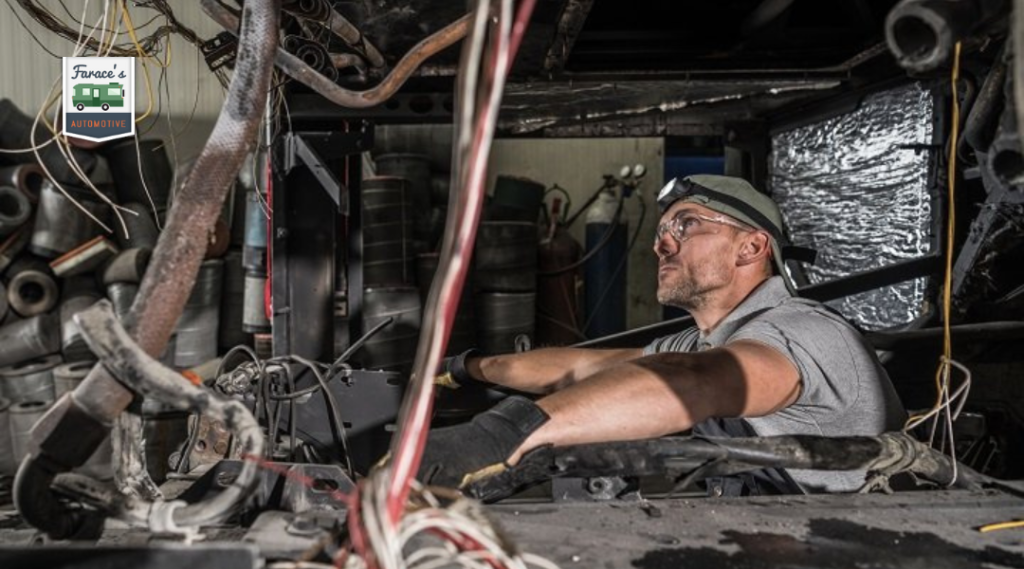
If your generator struggles to start, stalls during use, or produces inconsistent power, it may need service. Low oil, clogged fuel lines, or dirty filters are common causes. Running a generator with these issues can shorten its lifespan.
You should also watch for burning smells, tripped breakers, or melted wiring insulation. These are signs of overheating circuits and pose a fire risk. Addressing electrical malfunctions quickly ensures both safety and reliability on the road.
Uneven Tire Wear Or Handling Problems
Tires give clear warnings when something is wrong. Uneven tread wear often points to alignment issues, suspension problems, or improper inflation. For example, excessive wear on the inside edge usually indicates misalignment, while cupping or scalloping can mean worn shocks or struts.
Handling changes are another warning. If your RV pulls to one side, requires constant steering correction, or feels unstable on turns, suspension or steering components may be failing.
Ignoring these signs risks blowouts, poor braking performance, and unsafe handling. Regular tire inspections and immediate attention to unusual wear patterns help keep your RV safe and roadworthy.
The Benefits Of Routine Service At Farace Automotive & RV Center
When you bring your RV in for maintenance, you want skilled technicians, a wide range of services, and fair pricing you can trust. Farace Automotive & RV Center provides all three, making it a dependable choice for keeping your RV safe and road-ready.
Over 40 Years Of RV Repair Expertise In Orange County
With more than four decades in business, Farace Automotive & RV Center has built a reputation for consistent, reliable service. Their long-standing presence in Orange County means they have worked on nearly every make and model of RV, from compact travel trailers to large motorhomes.
You benefit from technicians who understand both older and newer systems. This experience helps them identify issues quickly and recommend the right solutions without unnecessary guesswork.
The shop’s history also reflects stability. A business that has operated for 40 years shows it can adapt to changing RV technology while maintaining customer trust. That kind of continuity gives you confidence your RV is in capable hands.
Full-Service Shop: From Oil Changes To Complete Restorations
Farace Automotive & RV Center offers a wide range of services under one roof. Routine maintenance like oil changes, tire rotations, and brake checks is handled with the same attention to detail as more complex repairs.
If your RV needs roof repairs, appliance servicing, or collision work, the shop has the tools and staff to complete the job. You won’t need to visit multiple locations for different repairs, which saves you time and reduces the risk of missed maintenance.
For owners of older RVs, complete restorations are also available. Whether it’s rebuilding a drivetrain, replacing electrical systems, or repairing bodywork, the team can return your RV to reliable condition.
Trusted By Local RV Owners For Quality And Fair Pricing
Many RV owners in Orange County rely on Farace Automotive & RV Center because of its reputation for fair pricing and consistent workmanship. Transparent estimates help you understand costs upfront, reducing surprises when the work is complete.
The shop focuses on doing the job correctly the first time, which helps prevent repeat visits for the same issue. That approach not only saves money but also keeps your RV on the road longer.
Local customers often return for regular maintenance because they know they will receive straightforward service without unnecessary upselling. This trust makes Farace a dependable option for both new and long-time RV owners.

